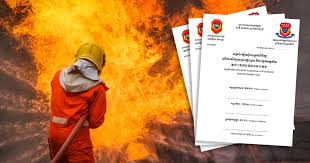
Introduction
Fire safety is a critical component of building design, particularly in a rapidly developing country like Cambodia. The increasing urbanization, industrial growth, and expansion of high-rise buildings necessitate robust fire protection measures. Fire safety design and installation in Cambodia must align with both local and international safety standards to ensure the protection of lives and property.
Fire Safety Regulations in Cambodia
Cambodia has been progressively enhancing its fire safety regulations to address the growing risks associated with urban development. The Fire Prevention and Firefighting Law, issued by the Cambodian government, outlines specific requirements for fire safety measures in buildings. Additionally, international standards such as the NFPA (National Fire Protection Association) and ISO (International Organization for Standardization) serve as guidelines for fire protection practices.
Some key aspects of Cambodian fire safety regulations include:
-
Mandatory fire detection and alarm systems in commercial and residential buildings
-
Provision of fire extinguishers and hose reels in strategic locations
-
Emergency exits and evacuation plans
-
Proper installation of fire suppression systems such as sprinklers and gas suppression units
-
Regular fire drills and staff training for emergency preparedness
Fire Safety Design Considerations
The design of fire safety systems involves various factors to ensure effective fire prevention, detection, and suppression. The following are essential considerations:
-
Building Classification and Risk Assessment
-
Identifying the type of building (residential, commercial, industrial, or mixed-use)
-
Evaluating potential fire hazards associated with the building’s function
-
-
Active Fire Protection Systems
-
Fire Alarm Systems: Installation of smoke detectors, heat sensors, and alarm control panels
-
Fire Suppression Systems: Use of water-based sprinklers, foam suppression, or gas suppression depending on the building type
-
Fire Extinguishers: Placement of appropriate extinguishers (CO2, dry chemical, foam, or water) in key areas
-
-
Passive Fire Protection Measures
-
Fire-resistant construction materials such as fire-rated doors, walls, and ceilings
-
Compartmentalization: Design strategies to prevent the spread of fire through fire barriers
-
Smoke control systems to enhance visibility and air quality during evacuation
-
-
Emergency Evacuation Planning
-
Clearly marked and unobstructed emergency exits
-
Fire escape staircases with adequate width and fire-resistant enclosures
-
Illuminated exit signs and emergency lighting systems
-
-
Fire Safety System Integration
-
Interconnection of alarm systems with suppression units and emergency lighting
-
Remote monitoring of fire safety equipment for early fault detection
-
Integration with local firefighting authorities for rapid response
-
Fire Safety Installation Process
The installation of fire safety systems follows a structured approach to ensure compliance with regulations and effectiveness in real-life situations. The process includes:
-
Initial Fire Risk Assessment
-
Conducting site inspections to identify fire hazards and risks
-
Consulting fire safety engineers for appropriate system design
-
-
System Design and Approval
-
Preparing detailed fire safety system blueprints
-
Obtaining necessary approvals from Cambodian fire safety authorities
-
-
Installation of Fire Protection Equipment
-
Mounting fire alarms, detectors, sprinklers, and suppression systems
-
Ensuring proper electrical and hydraulic connections for system efficiency
-
-
Testing and Commissioning
-
Conducting fire drills and equipment testing to verify functionality
-
Training building occupants and staff on fire safety protocols
-
-
Maintenance and Periodic Inspection
-
Routine checks and servicing of fire safety equipment
-
Updating fire safety systems in response to regulatory changes
-
Challenges and Future Developments
Despite improvements in fire safety design and installation, Cambodia faces challenges such as:
-
Lack of awareness and training among building owners and occupants
-
Enforcement issues due to limited resources in fire safety authorities
-
High costs of advanced fire protection systems leading to non-compliance in smaller buildings
To address these challenges, the Cambodian government is focusing on:
-
Strengthening fire safety education and training programs
-
Increasing enforcement of fire safety laws through inspections and penalties
-
Encouraging investment in innovative fire protection technologies
Conclusion
Fire safety design and installation in Cambodia are crucial for protecting lives and property in an increasingly urbanized environment. Adhering to national and international standards, implementing effective fire protection systems, and fostering a culture of fire safety awareness will significantly reduce fire-related risks. By continuously improving regulations, enforcement mechanisms, and technological advancements, Cambodia can ensure safer buildings and communities for future generations.




Leave a Reply